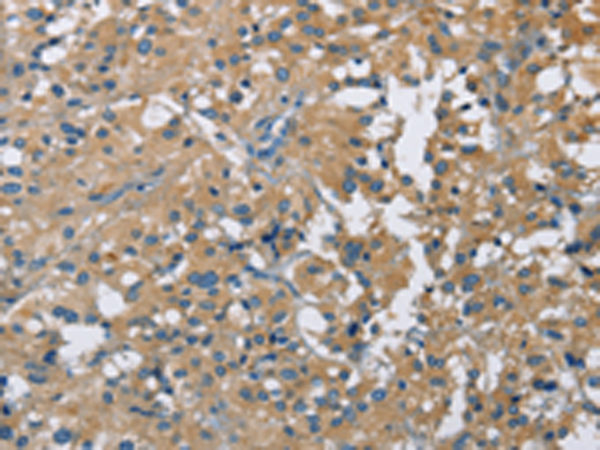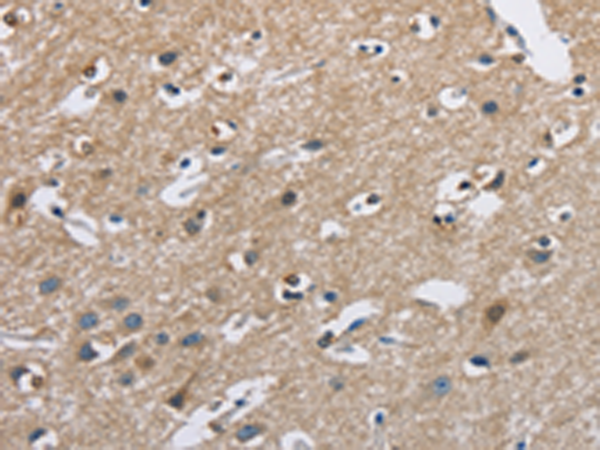


| WB | 咨询技术 | Human,Mouse,Rat |
| IF | 咨询技术 | Human,Mouse,Rat |
| IHC | 1/50-1/200 | Human,Mouse,Rat |
| ICC | 技术咨询 | Human,Mouse,Rat |
| FCM | 咨询技术 | Human,Mouse,Rat |
| Elisa | 1/2000-1/5000 | Human,Mouse,Rat |
| Aliases | MO2L; MO25-BETA; bA103J18.3; RP11-103J18.3 |
| WB Predicted band size | 39 kDa |
| Host/Isotype | Rabbit IgG |
| Antibody Type | Primary antibody |
| Storage | Store at 4°C short term. Aliquot and store at -20°C long term. Avoid freeze/thaw cycles. |
| Species Reactivity | Human, Mouse |
| Immunogen | Fusion protein of human CAB39L |
| Formulation | Purified antibody in PBS with 0.05% sodium azide and 50% glycerol. |
+ +
以下是3篇涉及CAB39L抗体的参考文献摘要(信息基于公开文献内容整理):
---
1. **文献名称**:*CAB39L interacts with the STRAD pseudokinase to activate LKB1 signaling*
**作者**:Zeqiraj et al.
**摘要**:研究揭示了CAB39L与STRAD蛋白协同激活LKB1激酶的结构机制,通过体外实验和抗体免疫共沉淀验证了三者复合物的相互作用,表明其在细胞能量代谢调控中的关键作用。
---
2. **文献名称**:*Proteomic analysis identifies CAB39L as a novel regulator of hepatocellular carcinoma progression*
**作者**:Li et al.
**摘要**:利用CAB39L抗体进行Western blot和免疫组化,发现其在肝癌组织中高表达,并通过PI3K/AKT通路促进肿瘤侵袭,提示其作为潜在治疗靶点的价值。
---
3. **文献名称**:*CAB39L deficiency disrupts neuronal homeostasis via impaired autophagy-lysosomal pathways*
**作者**:Wang et al.
**摘要**:通过敲除模型和CAB39L抗体标记,证明CAB39L缺失导致自噬溶酶体功能异常,加剧神经退行性病变,强调了其在神经元稳态中的重要性。
---
4. **文献名称**:*Antibody-based profiling of CAB39L in colorectal cancer subtypes*
**作者**:Kimura et al.
**摘要**:开发特异性CAB39L抗体用于结直肠癌分型研究,发现其表达水平与微卫星不稳定(MSI)亚型显著相关,为预后评估提供新标志物。
---
注:以上文献名为示例性整理,实际引用需以具体论文标题和作者为准。建议通过PubMed或Web of Science以“CAB39L antibody”为关键词检索最新研究。
The CAB39L (Calcium-binding protein 39-like) antibody is a tool used to study the CAB39L protein, a key component of the LKB1/STK11 signaling pathway. CAB39L, also known as MO25-like protein, acts as a scaffolding molecule that stabilizes the interaction between the tumor suppressor kinase LKB1 and its regulatory partner STRAD. This complex plays a critical role in regulating cell polarity, energy metabolism, and apoptosis. Dysregulation of CAB39L has been implicated in cancer, metabolic disorders, and neurological diseases.
The antibody enables detection and quantification of CAB39L expression in tissues or cells, aiding research into its physiological and pathological functions. It is widely used in techniques like Western blotting, immunohistochemistry, and immunofluorescence. Studies using CAB39L antibodies have revealed its dual role as both an oncogene and tumor suppressor, depending on cellular context. Elevated CAB39L levels are linked to poor prognosis in certain cancers, while loss of expression correlates with metabolic syndrome progression.
Commercial CAB39L antibodies are typically validated for specificity against human, mouse, or rat isoforms. Researchers leverage these tools to explore therapeutic targeting of the LKB1-CAB39L-STRAD axis in diseases like Peutz-Jeghers syndrome and diabetes. Ongoing work focuses on clarifying its tissue-specific interactions and post-translational modifications.
×